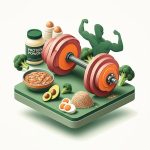For the bigger picture and full context, make sure you read our main guide on 20 lbs of Fat: What It Really Looks Like?.
markdown
Imagine lugging around a bowling ball everywhere you go. That’s roughly the equivalent of carrying an extra 20 pounds of fat. But it’s not just about weight; it’s about volume, impact, and, most importantly, what you can do about it.
At a glance:
- Understand the visual impact of 20 pounds of fat gain or loss on your body.
- Learn how fat distribution affects your appearance and health differently.
- Discover strategies to lose 20 pounds of fat safely and effectively.
- Address common misconceptions about weight loss and body composition.
- Craft a personalized plan for losing 20 pounds that aligns with your lifestyle.
The Visual Impact: Beyond the Numbers
It’s easy to get hung up on the number on the scale. But 20 pounds of fat has a tangible presence. Think of it occupying the same space as a medium duffel bag. See how 20 lbs looks, and you’ll understand that it’s not just a matter of numbers; it’s a visible transformation.
One pound of fat takes up more space than one pound of muscle. So, losing 20 pounds of fat can make a dramatic difference in how your clothes fit and how you look. This is where the “paper towel effect” comes in. Initially, the change seems subtle similar to removing some sheets off a roll of paper towel. But you need to take off more sheets to notice. However, as you lose additional weight, the changes become more apparent with each passing week.
Where Does It Go? Understanding Fat Distribution
Not all fat is created equal, and where it’s stored matters. Genetics, hormones, and gender all play a role.
- Men: Typically store fat around the abdomen (visceral fat), increasing the risk of heart disease and other health issues. An increase of 20lbs could visually translate to a larger belly and potentially a broader face.
- Women: Often accumulate fat in the hips, thighs, and buttocks. Gaining 20lbs might show up as larger thighs and a rounder backside.
The distribution impacts not only appearance but also health risks. Visceral fat, stored deep within the abdomen, is particularly dangerous because it surrounds organs and releases harmful substances into the bloodstream.
Example: Sarah and John both gain 20 pounds. Sarah notices it mostly in her thighs and hips, while John’s waistline expands significantly. While both have gained weight, John faces a potentially higher risk of developing metabolic issues due to the location of his fat storage.
The Health Implications: More Than Just Aesthetics
Excess fat, especially visceral fat, is linked to a range of health problems, including:
- Heart disease
- Type 2 diabetes
- High blood pressure
- Certain types of cancer
- Fatty liver disease
- Hormonal imbalances
- Sleep apnea
Losing 20 pounds can significantly reduce these risks, improving your overall health and well-being beyond just appearance.
The Psychological Boost: Confidence and Well-being
Losing 20 pounds isn’t just about physical changes; it’s a mental game-changer. Many people report:
- Increased self-esteem and confidence
- Improved body image
- Greater energy levels
- Enhanced mood and reduced stress
Imagine feeling lighter, more agile, and more confident in your own skin. That’s the potential power of shedding those extra pounds.
The 20-Pound Loss Playbook: A Practical Guide
Losing 20 pounds of fat requires a strategic approach, combining diet, exercise, and lifestyle adjustments.
Step 1: Calculate Your Calorie Deficit
To lose weight, you need to burn more calories than you consume. A deficit of 500-750 calories per day typically leads to a weight loss of 1-2 pounds per week. Use an online calculator to estimate your daily calorie needs based on your age, sex, activity level, and weight loss goals.
Step 2: Prioritize a Protein-Rich Diet
Protein is crucial for weight loss because it helps you feel fuller for longer, reduces cravings, and preserves muscle mass. Aim for at least 0.8 grams of protein per pound of body weight. Include sources like lean meats, poultry, fish, eggs, beans, lentils, and tofu in your diet.
Example: A 150-pound person should aim for at least 120 grams of protein per day.
Step 3: Embrace Cardiovascular Exercise and Resistance Training
- Cardio: Activities like running, swimming, cycling, and dancing burn calories and improve cardiovascular health. Aim for at least 150 minutes of moderate-intensity or 75 minutes of vigorous-intensity cardio per week.
- Resistance Training: Lifting weights or doing bodyweight exercises helps build muscle mass, which increases your metabolism and helps you burn more calories even at rest. Aim for two to three resistance training sessions per week, focusing on all major muscle groups.
Step 4: The 80/20 Rule
Allow yourself to enjoy your favorite foods in moderation. Follow the 80/20 rule: eat healthy, whole foods 80% of the time and indulge in treats 20% of the time. This approach makes weight loss more sustainable and prevents feelings of deprivation.
Step 5: Hydration, Sleep, and Stress Reduction - Hydration: Drink plenty of water throughout the day to stay hydrated and help control your appetite.
- Sleep: Aim for 7-9 hours of quality sleep per night. Lack of sleep can disrupt hormones that regulate appetite, leading to increased cravings and weight gain.
- Stress Reduction: Practice stress-reducing activities like yoga, meditation, or spending time in nature. Chronic stress can lead to increased cortisol levels, which can promote fat storage, especially in the abdominal area.
Muscle vs. Fat: The Scale Can Be Deceiving
The scale doesn’t always tell the whole story. If you’re gaining muscle while losing fat, the number on the scale may not change as much as you expect. Muscle is denser than fat, so it takes up less space.
Example: You lose 5 pounds of fat but gain 5 pounds of muscle. The scale might stay the same, but your body composition has improved significantly. Your clothes will fit better, and you’ll look leaner.
Focus on:
- Body measurements (waist circumference, hip circumference)
- How your clothes fit
- Progress photos
- Body fat percentage (if available)
These metrics provide a more accurate picture of your progress than the scale alone.
Common Misconceptions: Debunking Weight Loss Myths
- Myth: Spot reduction (targeting fat loss in specific areas) is possible.
- Fact: You can’t choose where you lose fat first. Fat loss occurs throughout the body, influenced by genetics and hormones.
- Myth: Extreme diets are the best way to lose weight quickly.
- Fact: Rapid weight loss is often unsustainable and can lead to muscle loss and a slower metabolism. Focus on gradual, healthy weight loss.
- Myth: All calories are created equal.
- Fact: While calorie balance is important, the source of those calories matters. Processed foods and sugary drinks can lead to weight gain and health problems, even if you’re within your calorie target.
Quick Answers: FAQs About Losing 20 Pounds of Fat
Q: How long will it take to lose 20 pounds of fat?
A: At a healthy rate of 1-2 pounds per week, it will take approximately 10-20 weeks to lose 20 pounds.
Q: What if I hit a plateau?
A: Plateaus are normal. Re-evaluate your calorie intake, increase your activity level, and consider adjusting your workout routine.
Q: Can I lose 20 pounds without exercise?
A: It’s possible, but exercise helps you burn more calories, build muscle, and improve your overall health. It’s highly recommended.
Q: What are some healthy snack options while trying to lose weight?
A: Greek yogurt with berries, a handful of almonds, apple slices with peanut butter, or a hard-boiled egg.
Your Actionable Path: A Personalized Plan
Here’s a simple framework to get started:
- Assess: Calculate your current daily calorie intake and macros (protein, carbs, fats).
- Adjust: Create a calorie deficit of 500-750 calories per day. Prioritize protein intake.
- Move: Incorporate at least 150 minutes of cardio per week and two to three resistance training sessions.
- Track: Monitor your progress using various metrics (weight, measurements, progress photos).
- Adapt: Re-evaluate your plan as needed and make adjustments to stay on track.
Losing 20 pounds of fat is a journey, not a sprint. Be patient, stay consistent, and celebrate your progress along the way. It’s about building sustainable habits and transforming your lifestyle for the better.
- Gluten Free Meal Prep Ideas for Delicious, Hassle-Free Eating - November 28, 2025
- Gluten Free Meal Prep for Stress-Free and Healthy Eating - November 27, 2025
- Quick And Easy Chicken Thigh Meal Prep For Weight Loss - November 26, 2025










